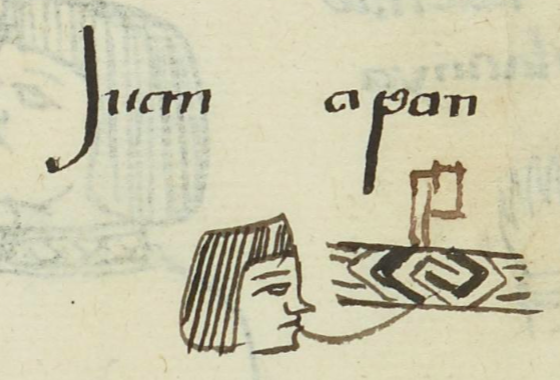Apan (MH602v)
This black-line drawing of the compound glyph for the personal name Apan (“Waterway” or "Canal") is attested here as a man’s name. It is what may be a canal (apantli) with a rectangular, "stepoed fret" swirl (sometimes called the xicalcoliuhqui design) in the center. Above the swirl, in a lighter-colored ink, is a banner (panitl)], which was added as a phonetic clue that this was not just atl (water), but a type of water.
The potential significance of the swirling water is brought home by the name glyph for Tetzauh (omen), which seems to suggest that whirlpools (and perhaps whirlwinds, and the like) create a vortex that connects life on earth with a spiritual realm. See below.
Stephanie Wood
Sometimes swirling water involves a rectangular coil. The potential significance of the swirling water is brought home by the name glyph for Tetzauh (omen), which seems to suggest that whirlpools (and perhaps whirlwinds, and the like) create a vortex that connects life on earth with a spiritual realm. See below.
Stephanie Wood
Juan apan
Juan Apan
Stephanie Wood
1560
waterways, canals, canales, channels, flags, banderas

apan(tli), waterway, canal, https://nahuatl.wired-humanities.org/content/apantli
a(tl), water, https://nahuatl.wired-humanities.org/content/atl
pan(itl), flag, banner, https://nahuatl.wired-humanities.org/content/panitl
-pan (locative suffix) water, https://nahuatl.wired-humanities.org/content/pan
xicalcoliuhqui, stepoed fret coil, https://nahuatl.wired-humanities.org/content/xicalcoliuhqui
El Canal
Stephanie Wood
Matrícula de Huexotzinco, folio 602v, World Digital Library, https://www.loc.gov/resource/gdcwdl.wdl_15282/?sp=286&st=image.
This manuscript is hosted by the Library of Congress and the World Digital Library; used here with the Creative Commons, “Attribution-NonCommercial-ShareAlike 3.0 License” (CC-BY-NC-SAq 3.0).





